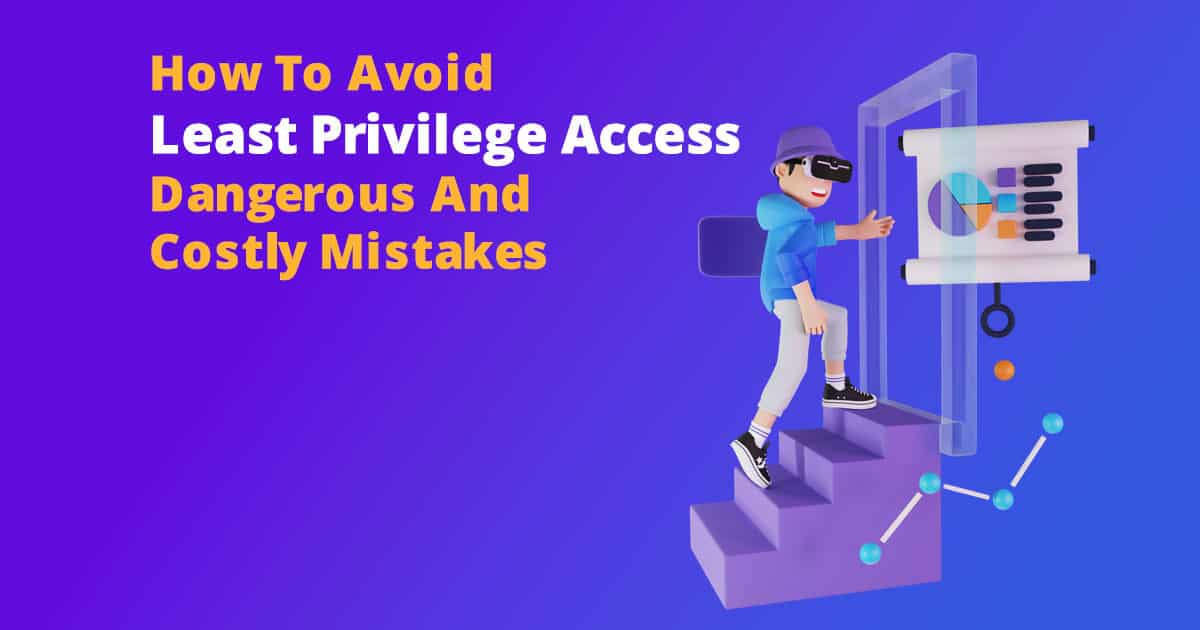
What Exactly Are Least Privilege Principles?
There is arguably nothing more important in network, business, and cyber security, than the concept of least privilege. Without question, it is an essential component of any data security system.
Ironically, it's the pure certainty, and resulting overconfidence, in Least Privilege Principles, that can lead to big problems for organizations. More about that soon.
Least privilege principles convey that any user, process or system, should only have access to the least amount of information, resources and capabilities, necessary to perform its intended job and/or function.
A Summary Of Least Privilege Principles
1. Access to all systems and networks should be authorized.
2. Individuals and systems which require access should only be granted the minimum access required to perform their job.
3. All changes or modifications to any person or system's access should be monitored and approved.
4. All activities and modifications should be audited and logged.
In theory, by adhering to this concept, a business can mitigate the potential destruction, data manipulation and proliferation of sensitive information that can happen when an account is compromised.
Additionally, it provides a way to limit the damage a user could unintentionally cause from a simple error or mistake.
As we'll see, this concept is great in theory but can be highly problematic in practice.
How Does POLP Compare And Utilize Other Security Frameworks?
It's essential to give a brief overview of the concepts, elements and systems, typically utilized within the traditional least privilege framework.
1. Identity and Access Management (IAM) - The software system used to grant users privileges, and manage user access in a scalable way. IAM systems, such as IDHub, provide the framework and interface to create and remove rules that govern user access, based on various criteria.
2. CIA Triad - The model for the desired security landscape involves three foundational core ideas that comprise the CIA Triad; Confidentiality, Integrity and Availability. The concept of least privilege is based on upholding these three ideas.
3. Need to Know - An extension of least privilege that applies specifically to confidential data. Need to Know can be implemented without an organizational POLP policy, and the least privilege can theoretically exist without making any data within the organization confidential.
4. Separation Of Duties (SOD) - This concept is supported by Least privilege and taken a step further.
SOD is the practice of identifying critical tasks that pose potential threats, and dividing those tasks into separate parts so that no single access provides the ability to complete the potential threat.
Least Privilege Examples
Scenario 1
Within an accounting department, you may have junior members who can see all data and pull reports based on the information. At a higher level, you may have users who can enter and edit data. Still, another group may be able to create new accounts, submit payments or delete information altogether.
Scenario 2
Within a Marketing department, you may have users who are permitted to post on social media behalf of the company. However, they cannot initiate paid advertising campaigns.
Scenario 3
An HR department may allow all employees to view their information, but not any other users.
An HR member may have access to view all user data, but not to edit or delete records.
Scenario 4
A development company may provide access to a server, but only for certain folders containing the specific projects they are working on as opposed to all folders on the network.
Where Least Privilege Principles Go Wrong
Least privileged access policies are costing companies time and money
Many businesses need help managing least privilege access policies across multiple platforms, devices, applications, etc.
The problem is, it's challenging to do this. As a result, many organizations spend more time figuring out how to ensure users access data appropriately, rather than focusing on what they want to accomplish as a department goal.
IT departments often spend too much time managing access rights, instead of focusing on business objectives.
Setting up least privileged access
The following is a list of steps you should go through when creating an outline and plan, for implementing least privileged access. We'll also provide specific information on how these steps can go very wrong.
1. Identifying who should have access to each system or application.
2. Identifying the different levels of access that can be granted.
3. Categorizing users into the appropriate roles and granting those users the minimum level of access necessary to perform their job.
4. Identifying edge cases where specific users would need additional access outside of their role and granting that access.
5. Monitor user access and document any changes or actions.
6. Establish processes and procedures for resetting passwords.
7. Establish temporary access roles which can be assigned by approved requests as needed.
These steps are essential to ensure the security of sensitive systems and data and should not be overlooked.
However, least-privilege access can present some challenges. For example, for your staff to function correctly, they need access to several system resources, including files, folders, devices, network connections, etc.
A problem arises when these steps are conducted without fully understanding the software and systems users need to access. In addition, administrators should understand the individual user's job responsibilities within each system.
Restrictions may limit or prevent the users from efficiently performing their job responsibilities, and can create more administrative overhead as IT personnel need to manage and constantly modify user access rights.
Organizations should always apply for the least privileged access wherever possible to ensure data security.
However, they should do so in a way that ensures they are not restricting users' abilities to do their jobs properly.
To do this, when planning for the least privilege access policy, you must meet with all of the stakeholders for each system and get a full review of the application and buy-in on precisely what the different access levels should be by default.
To implement least privilege practices properly, organizations must create a clear understanding of each user's job function and responsibilities. This includes determining which systems and data are required for those tasks.
It would be best if you also discovered what the expected occasional additional access levels will be and what rare scenarios might happen.
Create a plan for each system, so you are prepared to deal with as many use cases and special requests as possible ahead of time. Take your time with planning when developing your policies.
Discovering Vulnerable Users - A Problem Least Privilege Principles Can Not Solve Alone
Many companies have a problem where there is a single point of failure for an entire department.
This usually happens when someone becomes a jack-of-all-trades, and takes on more responsibilities than they are qualified for.
This can happen because the company still needs to formalize a system for assigning duties and responsibilities. Or perhaps the employee feels pressured to do more than his job description allows him to do.
The result is, at best, a situation where the company puts all its eggs in one vulnerable basket or an inefficient organization where everyone has to wait for another person to finish what they started.
To avoid these problems, rather than providing this individual user full access to everything, work with stakeholders to define and set clear expectations for each individual within the team.
This is a good scenario where separation of duties would make sense.
For example, suppose you have one individual doing everything in accounting, such as paying vendors and creating vendors to pay.
In that case, you could separate those into two different roles.
Make sure everyone knows what they are responsible for and will have access to and that no one is locked out from the ability to do their work efficiently.

The Not-So Holy Grail Of Least Privilege Principles
The problem with the least privilege principle is that it assumes that security is an absolute value. If we could achieve perfect security for everyone, there would be no reason to worry about security.
By this standard, the safest possible solution would be to turn off all of the computers in the system, thereby guaranteeing there would not be any breaches, data loss, or internal sabotage.
This obviously absurd scenario makes a clear point, security is a game of costs, benefits, and trade-offs.
We cannot achieve perfect security. We can only strive toward perfection. To do our best, we must make hard decisions.
This means we must accept that sometimes we may have to give up some level of convenience in exchange for security. Sometimes, we may have to give up some security for the business to operate correctly.
Our goal shouldn't be to protect users from themselves, or every possible threat. Instead, our goal should be to help them become as educated and secure as possible.

Users circumvent the least privileged access policies at their company.
When users need access to the data they need for jobs they were assigned with a high priority to complete, it's understandable that they get frustrated.
This situation comes from a few different breakdowns.
1. Lack of communication between the manager and the IT department that this might be a necessary responsibility.
2. Lack of awareness by the manager that this access would not be available to the user.
3. Lack of awareness by the end user that this is how the system was designed and the knowledge of protocols to secure the necessary access.
It's common in situations like this when time is a factor for users to share access or to circumvent the security in some other way.
This behavior can spread and eventually completely nullify your least privileged system, putting your business at a more significant risk than before.
This happens because there needs to be a clear available policy that explains precisely which actions each user can perform and how to request additional access when required.
There may also be a need for clarification on what privileges mean. For example, users may think they have more rights than they actually do.
To combat these issues, we recommend that companies develop a comprehensive least privilege policy that clearly defines the roles and responsibilities of each employee.
A well-written policy will explain what each role is permitted to do, what actions they are allowed to take, how to request additional access, and what consequences they face if they violate the policy.
Once employees understand the scope of their authority, they'll be much more likely to follow the rules.
The Overzealous Administrator
Another common mistake when creating an effective least privilege access policy is thinking it's a set of rules.
Rules are for following. Rules are for obeying. The reality is that the least privileged approach is more of a way of thinking. A mindset, an attitude, or perspective.
A mindset where you look at security from the user point of view too. Asking yourself, how much damage could happen if someone gained unauthorized access?
What would that person do once he had access? What could he do?
This kind of thinking makes the least privilege approach effective because it doesn't focus on rules. Instead, it focuses on the impact of actions.
This problem comes to a head when you have different departments with different agendas that are at odds with each other. For example, a department focused on production, and an IT team focused on security, and they are both correct.
To apply the least privilege approach effectively, you need to adopt a mindset where you consider the consequences of each action.
That means asking questions such as these:
1. What would the attacker do after gaining access?
2. How easy would it be for him to escalate his privileges?
3. Would he be able to compromise additional systems?
4. Is there any data that might be compromised?
5. Is this access restricted as a matter of policy, or is it a matter of Security?

Businesses Lose Productivity Due To Least Privilege Policies
The most effective way to reduce security vulnerabilities is to ensure everyone is as educated as possible and knows how to protect themselves.
When we look at many current systems, the opposite is happening. We are making daily responsibilities more time-consuming and challenging to accomplish in optimal time frames.
Users often don't know which permissions they might need for different scenarios.
For example, let's say you have a business application that allows shipping managers to create purchase orders.
If, for instance, the manager needed to place a rush order for supplies but needed to update the company credit card information and didn't have access to edit the payment information, it could cost the company significantly.
In another example, you may have a designer working on a project and only has access to that project's folder.
They need access to artwork in another project folder.
There would be no security risk to them having access to the art files, but because they were not on the project, they did not have access.
If time is limited, rather than submitting a request for access, the designer may spend an hour recreating it, rather than submitting a request and waiting.
This is another example of where meeting with managers and discussing possible scenarios while weighing a risk-benefit analysis is so important.
The IT Overhead Of Inefficient POLP Policies
The stricter your POLP policy is, the more time you will spend enforcing, modifying, and documenting all the steps you take to maintain it.
These costs can show up in various places, but notoriously in late projects outside the realm of access that are neglected to maintain all of the access tasks that take precedence.
It's common for businesses to lose money through complex, tightly regulated, but poorly planned policies.
They've been working hard to keep their networks secure for years, but now they realize that they've been focusing more on keeping out hackers than on keeping in customers.
They're losing money because they need to spend more time protecting themselves against security breaches instead of launching new initiatives and tools that will help sell their product.
One solution to consider is to utilize IAM systems with automated provisioning.
This will allow certain application rights to be granted to users upon request without involving the IT department.
This method will allow managers to approve user requests without waiting on anyone else.
Consider Where The Concept Of Least Privilege Can Be Applied In Custom Development Projects.
You may encounter a situation where a user needs specific access to something that is only granted by giving them a much larger range of access rights.
The level of access required might be too sensitive for them to maintain at all times. In these cases, a ticket must be submitted for access, approved, provisioned, and then access removed upon completion.
Consider the following scenario. A copywriter on your staff is tasked with updating the company website once a month.
To do this, they need access to the entire site, which is too risky to let them have indefinitely.
Instead of creating new timed access requests that must be processed monthly, a front-end form could be built that loads the information onto the site without accessing the back end.
With a bit of creativity, you can discover many situations where your team could create a less sensitive bridge to a secure application where access could be granted indefinitely without compromising Security.

The Primary Problem Of Protecting User Access Is Still A Problem
The most common form of data breaches remains at the human level.
Having a proper and well-defined Least Privilege Access Policy in place, will help protect you in so much as a hacked account will only have access to what the user had access to.
The problem arises again that we are too dependent on the least privilege and less focused on education.
Hackers are becoming more sophisticated and increasingly creative. So, they'll find ways to exploit any weakness, whether it's a vulnerability in your code, an unmatched system flaw, or a human vulnerability.
This means we must find ways to protect our most valuable assets without relying solely on technology.
You need to train your staff to be aware of these kinds of issues and to be able to spot them before they become problems.
The key here is that we must ensure that everyone within the organization is aware of the risks involved. In addition, everyone needs to understand the importance of keeping their personal devices secure and protected.
Along with understanding the threat landscape, we must also ensure that employees are trained to recognize when they've been compromised.
This isn't just about educating them; it's about empowering them to act quickly and decisively when they suspect their devices or accounts may have been breached.
Finally, we need to empower our users to keep themselves safe. This includes providing them with tools and resources to help them stay vigilant and avoid falling victim to bad actors and social manipulation attempts.
An environment that does not focus on education is one where all individuals, including those with highly privileged access, have not been educated properly.
This would create a significantly vulnerable point of entry.
Advanced Strategies for Implementing Least Privilege
While foundational practices like Role-Based Access Control (RBAC) and regular access reviews are essential, organizations can further strengthen their security posture by adopting advanced strategies:
Just-in-Time (JIT) Access Provisioning
Implementing JIT access ensures that users receive elevated privileges only when necessary and for a limited duration. This minimizes the window of opportunity for potential misuse or exploitation of privileged accounts. By granting temporary access rights, organizations can reduce the risk of privilege escalation attacks and maintain tighter control over sensitive resources.
Attribute-Based Access Control (ABAC)
ABAC offers a more granular approach to access management by considering user attributes, environmental conditions, and resource sensitivity. This dynamic method allows for context-aware access decisions, ensuring that permissions align precisely with current operational needs. For instance, access can be restricted based on factors like time of day, location, or device type.
Separation of Duties (SoD)
Enforcing SoD policies helps prevent conflicts of interest and reduces the risk of fraud or error by dividing responsibilities among multiple individuals. For example, the person who approves a financial transaction should not be the same individual who initiates it. Implementing SoD ensures that critical tasks require oversight and collaboration, enhancing accountability.
Leveraging Automation for Least Privilege Enforcement
Automation plays a pivotal role in maintaining and scaling least privilege principles across complex IT environments:
Automated Access Reviews and Certifications
Regularly scheduled, automated access reviews help organizations promptly identify and revoke unnecessary privileges. By integrating automation into the certification process, businesses can ensure continuous compliance with internal policies and external regulations, such as GDPR and HIPAA.
Privileged Access Management (PAM) Solutions
Deploying PAM tools enables organizations to monitor, control, and audit privileged account activities effectively. These solutions offer features like session recording, real-time alerts, and automated password rotations, which are crucial for detecting and responding to suspicious behaviors promptly.
Integration with Identity and Access Management (IAM) Systems
Integrating least privilege strategies with IAM systems ensures a cohesive approach to user provisioning and deprovisioning. Automated workflows can adjust access rights in real-time based on role changes, terminations, or other HR events, thereby reducing the risk of privilege creep and orphaned accounts.
By incorporating these advanced strategies and automation techniques, organizations can enhance their security frameworks, ensure compliance, and effectively manage user access in today's dynamic digital landscape.
Summary of tips for avoiding Least Privilege Access Problems.
1. Don't rush or skimp on planning your policies
2. Get buy-in and cooperation from each resource stakeholder when setting up your policies.
3. Create clearly defined roles and functions for individuals in the company, so they know their responsibilities and how to request access if needed.
4. Gauge cost/risk benefits when setting up user privileges to evaluate productivity vs. policy and make decisions based on what's best for the company, overall.
5. Always educate team members on why your security works the way it does, what current threats are and how to avoid them.
6. Build systems to bridge lower-level access with specific actions that would otherwise require sensitive access to work with.
7. Automate as many processes as possible to save yourself time managing repetitive, less secure requests.
8. Be flexible with your plans to work with other team members for the best possible outcome.
9. Learn key IAM phrases and terms in our IAM Glossary.
